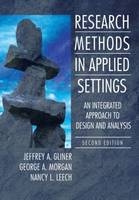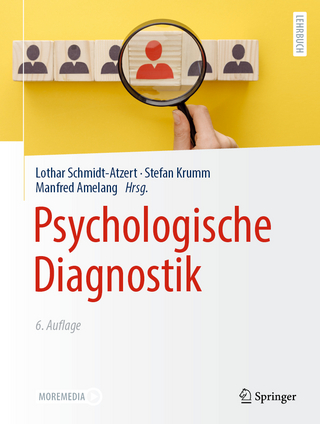
Research Methods in Applied Settings
Routledge (Verlag)
978-0-8058-6434-2 (ISBN)
- Titel erscheint in neuer Auflage
- Artikel merken
Through its integrated approach to quantitative research methods, this text teaches readers how to plan, conduct, and write a research project and select and interpret data so they can become better consumers of research. This is not a statistics book—there are very few formulas. Rather, this book helps students master which statistic to use when and how to interpret the results. Organized around the steps one takes in conducting a research project, this book is ideal for applied programs and for those who want to analyze and evaluate research articles. Having taught in a variety of departments, the authors have a good grasp of the research problems faced by master’s and doctoral students in diverse areas of the behavioral and social sciences.
Text adopters applaud the book’s clarity. Students are often confused by other texts’ use of inconsistent terminology. To avoid this confusion, the authors present a semantically consistent picture that emphasizes five research approaches-- randomized experimental, quasi-experimental, comparative, associational, and descriptive. The authors then show how these approaches lead to three kinds of research designs which, in turn, lead to three groups of statistics with the same names. This consistent framework increases comprehension and the ability to apply the material. Numerous applied problems, annotated examples, and diagrams and tables further promote comprehension. Although the book emphasizes quantitative research, the value of qualitative research is introduced.
This extensively revised edition features more than 50% new material including:
A new chapter on the evidence-based approach that emphasizes the importance of reporting confidence intervals and effect sizes and the increased use of meta-analysis.
An increased emphasis on evaluating research including an 8 step plan for evaluating research validity (Chs. 23 & 24) and its application to the 5 sample studies used throughout the book (Ch. 25).
Lots of practical advice on planning a research project (Ch. 2), data collection and coding (Ch. 15), writing the research report (Ch. 27), questions to use in evaluating a research article (Appendix E) and creating APA tables and figures (Appendix F).
A new chapter on non-experimental approaches/designs (Ch. 7) including qualitative research.
Web resources for students including critical thinking problems with answers and a sample outline of a research proposal.
An earlier and expanded introduction to measurement reliability and validity to further emphasize their differences and importance.
An extensively revised chapter on measurement validity consistent with the latest APA/AERA/NCME standards.
Fewer chapters on inferential statistics with an increased focus on how their selection is related to the design of the study and how to interpret the results using significance testing and effect sizes and confidence intervals.
Instructor’s Resources with Power Points, test questions, answers to the application questions, and more.
Intended for graduate research or quantitative/experimental methods/design courses in psychology, education, human development and family studies, and other behavioral, social, business, and health sciences, independent sections and chapters can be read in many orders allowing for flexibility in assigning topics. Due to its practical approach, this book also appeals to researchers and clinicians. Prior exposure to statistics and research methods is recommended.
Jefferey A. Gliner is Professor Emeritus of Occupational Therapy at Colorado State University. He received his Ph.D. in psychology from Bowling Green State University and taught of graduate level research methods, statistics, and program evaluation courses to masters and doctoral level students for more than 20 years. George A. Morgan is a Professor Emeritus of Education and Human Development at Colorado State University. He received his Ph.D. in child development and psychology from Cornell University. He taught research methods and applied statistics to graduate students in several departments at Colorado State. In addition to writing textbooks on SPSS and research methods, he currently advises students on their dissertation research. Nancy Leech is an Associate Professor at the University of Colorado in Denver. She received her Ph.D. in education with an emphasis on research and statistics from Colorado State University in 2002. Dr. Leech is currently teaching graduate level courses in research, statistics, and measurement.
Preface. Part 1. Introductory Chapters. 1. Definitions, Purposes, and Dimensions of Research. 2. Planning a Quantitative Research Project. Part 2. Quantitative Research Approaches, Questions, and Designs. 3. Variables, Research Questions, and Hypotheses. 4. Research Approaches. 5. Randomized Experimental and Quasi-Experimental Designs. 6. Single-Subject Designs. 7. Nonexperimental Approaches and Designs. 8. Internal Validity. Part 3. Sampling, Measurement and Data Collection. 9. Sampling and Introduction to External Validity. 10. Measurement and Descriptive Statistics. 11. Measurement Reliability. 12. Measurement Validity. 13. Types of Data Collection Techniques. 14. Ethical Issues in Conducting the Study. 15. Practical Issues in Data Collection and Coding. Part 4. Data Analysis and Interpretation. 16. Making Inferences from Sample Data I: The Null Hypothesis Significance Testing Approach. 17. Making Inferences From Sample Data II: The Evidence-Based Approach. 18. General Design Classifications for Selection of Difference Statistical Methods. 19. Selection of Appropriate Statistical Methods: Integration of Design and Analysis. 20. Data Analysis and Interpretation – Basic Difference Questions. 21. Analysis and Interpretation of Basic Associational Research Questions. 22. Analysis and Interpretation of Complex Research Questions. Part 5. Evaluating and Writing Research Reports. 23. Evaluating Research Validity: Part I. 24. Evaluating Research Validity: Part II. 25. Narrative Evaluations of the Five Sample Articles. 26. Evaluating Research for Evidence-Based Practice. 27. Writing the Research Report. Appendixes A. Suggested Readings. B. Confusing Terms. K. Kidd, C. Glossary. D. Writing Research Problems and Questions. E. Questions for Evaluating Research Validity. D. Quick, F. Making APA Tables and Figures. References. Indexes.
| Erscheint lt. Verlag | 24.7.2009 |
|---|---|
| Zusatzinfo | 46 Tables, black and white; 55 Illustrations, black and white |
| Verlagsort | New York |
| Sprache | englisch |
| Maße | 174 x 246 mm |
| Gewicht | 1021 g |
| Themenwelt | Geisteswissenschaften ► Psychologie |
| ISBN-10 | 0-8058-6434-2 / 0805864342 |
| ISBN-13 | 978-0-8058-6434-2 / 9780805864342 |
| Zustand | Neuware |
| Haben Sie eine Frage zum Produkt? |
aus dem Bereich



